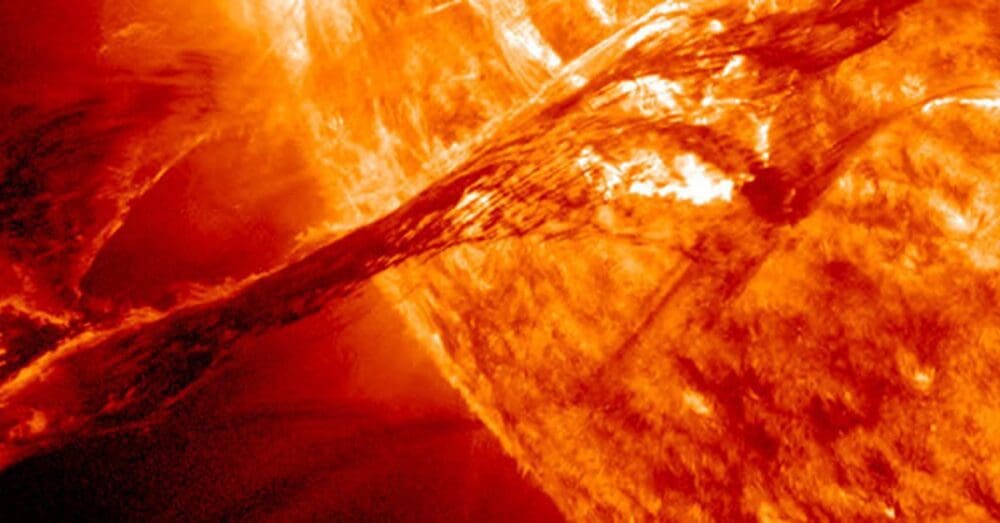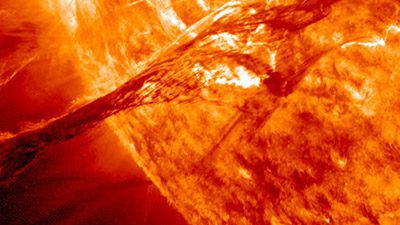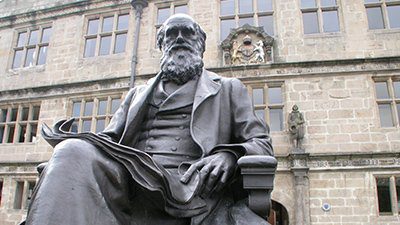
I first wrote about the young faint sun paradox nearly 25 years ago.1 The current theory of stellar structure and evolution was worked out in the late 1950s. By the mid-1960s, astronomers realized that according to this theory, early in its 4.5-billion-year history, the sun would have been much fainter than it is today. Thus, the early earth would have received far less heat from the sun, which would have resulted in the earth’s oceans freezing, a condition that the earth would have had difficulty recovering from even as the sun gradually brightened over 4.5 billion years. Compounding this problem, evolutionary geologists and biologists don’t think the earth ever was in such a state in its early history. Hence there is a paradox of how the earth could have maintained nearly the same average temperature while the sun slowly brightened throughout earth’s history.
According to Sagan, ammonia slowly dissipated, reducing its greenhouse effect as the sun gradually brightened.
Attempted Solutions
A half-century ago, Carl Sagan was the first astronomer to attempt to resolve the young faint sun paradox. Sagan proposed that ammonia was dominant in the earth’s early atmosphere. A strong greenhouse gas, ammonia would have allowed sunlight to pass through the atmosphere but blocked outgoing infrared radiation, effectively heating the earth. According to Sagan, ammonia slowly dissipated, reducing its greenhouse effect as the sun gradually brightened. That solution seemed to satisfy most planetary scientists until it was realized that solar ultraviolet light would quickly break down ammonia.
Over the decades, other scientists followed Sagan’s lead with proposals of other greenhouse gases providing heat on the early earth, with those gases slowly being eliminated as the sun brightened. Candidates for this role included methane and carbon dioxide. Problems soon developed with each proposed resolution to the paradox. For instance, some proposed greenhouse gases would have resulted in increased cloud cover on earth, with clouds reflecting away much of the incoming energy that the greenhouse gases were supposed to hold in. If the incoming radiation never reached the ground, then the mechanism to avoid the young faint sun paradox could not work.
Other variations were added to this theme. For instance, some proposals used the problem of changing albedo (reflectivity) of the earth as part of the solution.2 Other proposals invoked the development and evolution of life on earth as a powerful agent that transformed the earth’s atmosphere as needed to counter the sun’s increasing luminosity. Another proposal was that repeated asteroid impacts on the early earth periodically released the required greenhouse gases that eventually dissipated, which required frequent renewal.3 An even more fanciful suggestion was that the early earth was closer to the sun and migrated outward as the sun brightened.4 Yet another weird proposal was that the sun was initially more massive than it is today. More massive stars are brighter, so this would seem to solve the problem, but a more massive sun would have increased brightness over time too. How is this problem solved? Simply hypothesize that the early, more massive sun experienced much mass loss to cancel out the sun’s increasing luminosity with age.
The Latest Proposal
Given the desperation to solve this intractable problem, it is not surprising that yet another solution to the young faint sun paradox is now in the news. This new solution sort of combines with another issue that biblical creationists have discussed for some time, the tidal evolution of the earth-moon system. The tidal interaction of the earth and moon is well understood and results in the moon spiraling away from the earth. This is not a problem for a young earth and moon, but it is a problem for an earth and moon that are much over a billion years old, because the measurements indicate the earth and moon would have been in contact a little more than a billion years ago. When the moon was much closer to the earth, it would have produced incredibly high tides on the earth. Evolutionists have developed all sorts of ways to get around this problem, but this new solution invokes those exceedingly high lunar tides to have heated the early earth to prevent the earth from being an ice world.5
It seems to escape the notice of the authors of each proposed solution that their proposals are processes that are unrelated to the sun’s increasing luminosity with no feedback mechanism.
These proposals repeated the same cycle over and over. A new resolution to the young faint sun paradox is presented and accepted as the definitive answer, only to have problems soon develop that then are supposedly solved by the next definitive answer. The trend now is to blend elements of several solutions to the young faint sun paradox into a hybrid. It seems to escape the notice of the authors of each proposed solution that their proposals are processes that are unrelated to the sun’s increasing luminosity with no feedback mechanism. These two independent processes supposedly operated over billions of years to counterbalance one another so that the earth remained habitable and warm. How probable is that? It is so improbable as to be impossible.
The Only Viable Solution
For the earth to survive as an abode of life, over billions of years the earth would have traced a very narrow path with disastrous consequences with the slightest deviation from the perfect path. This is in addition to many other coincidences, such as the appearance of life on earth. Even within the billions-of-years paradigm, it is very clear that the earth is a very special, unique place. This leads one back to special creation. If special creation is true, then evolution is not true. If evolution is not true, billions of years are not necessary. Thus, an objective examination of the young faint sun paradox leads to the conclusion of recent creation, as described in Genesis 1.



















